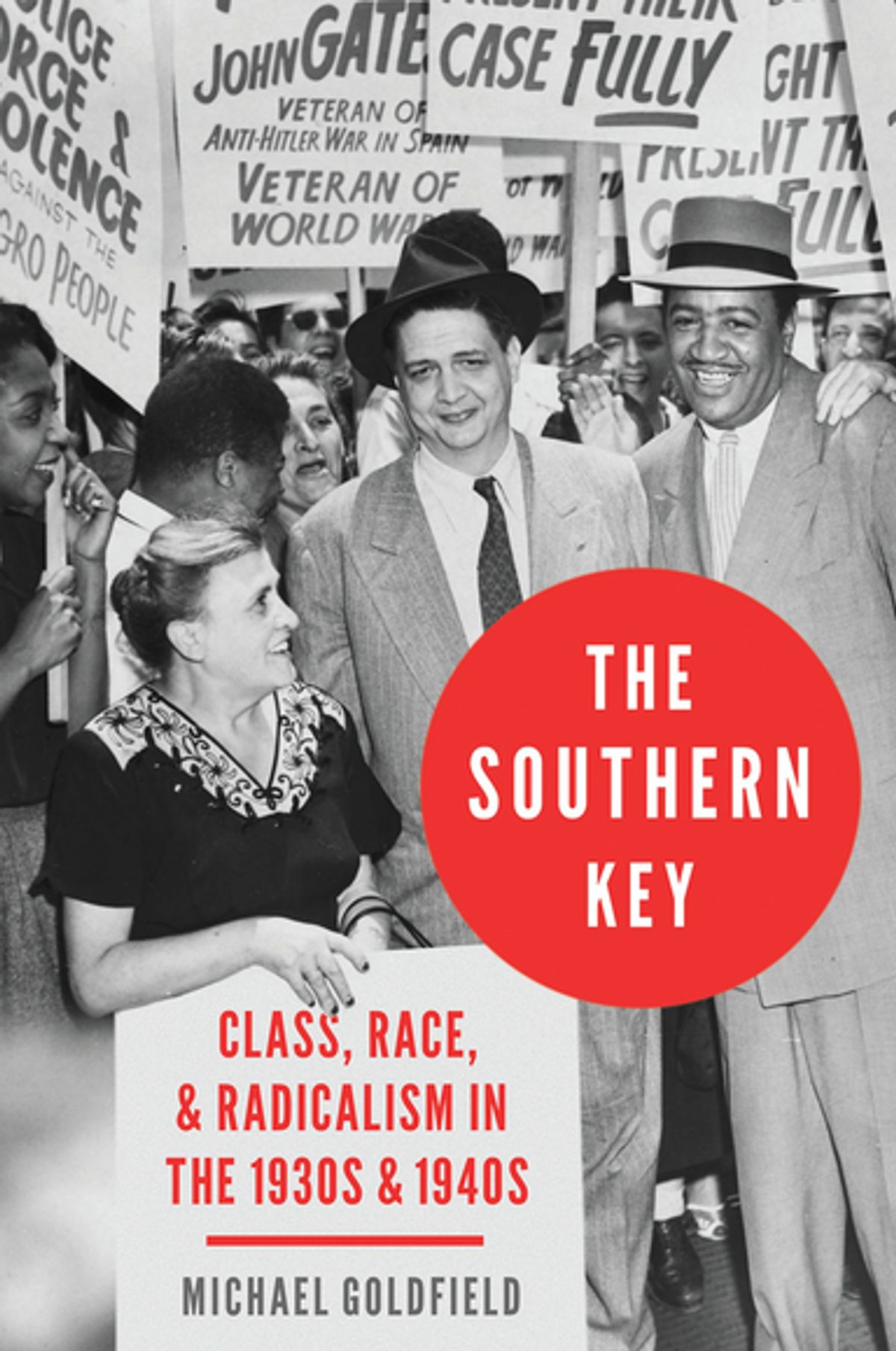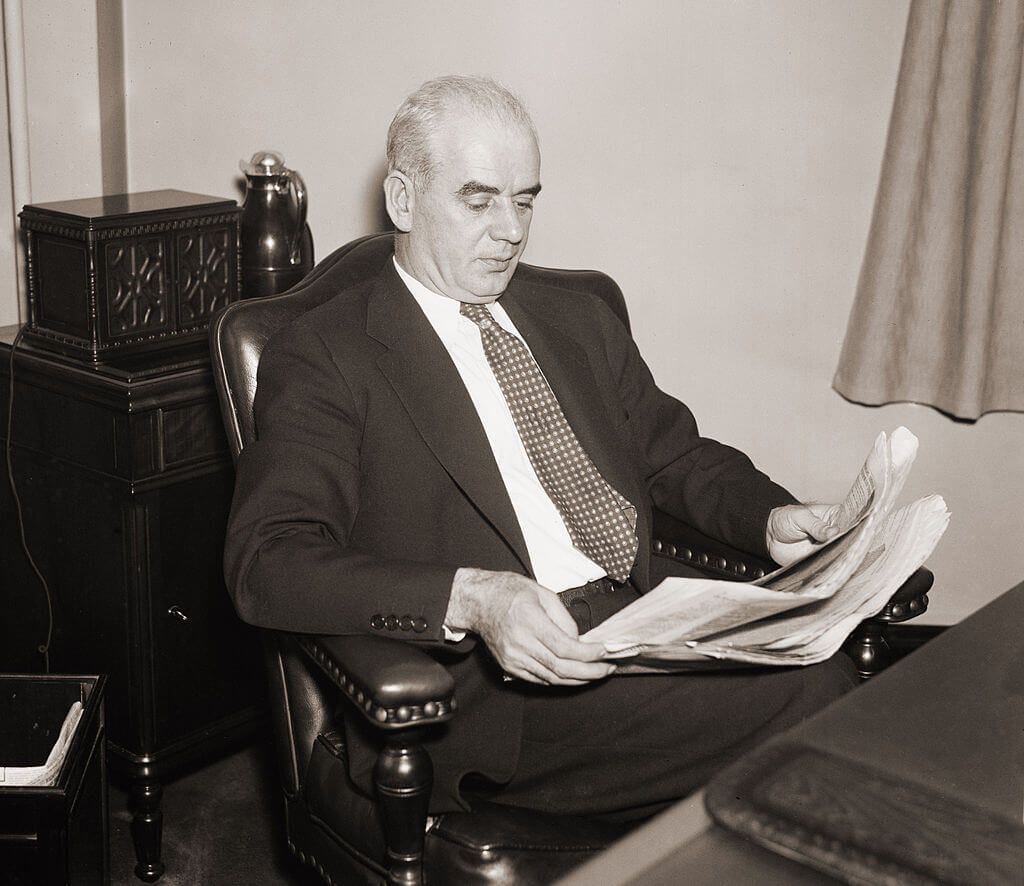This is our second entry for this week’s roundtable discussion on Michael Goldfield’s new book, The Southern Key: Class, Race, and Radicalism in the 1930s and 1940s. Goldfield examines the failure to organize the South in the period of the workers insurgency of the 1930s and 1940s. He argues that the fate of the South determined the fate of the nation, and that unionization was the key to transforming the region. He asks important questions about whether it could have been organized, examining an extensive array of published and archival sources.

We will post a new contribution to the roundtable each day for most of the week. The four roundtable commentators focus on key themes in Goldfield’s book. Here is our schedule:
July 13: James Gray Pope discusses the key premises of The Southern Key, suggests the evidence Goldfield presents makes for a usable history, and suggests the book raises important questions about the role of democracy in unions and radical organizations. July 14: Ahmed White focuses on Goldfield’s treatment of the Steelworkers union, and then raises important questions about counterfactuals and repression. July 15: William Jones questions whether Goldfield has addressed the intersection between law and politics adequately, and suggests he neglects the organizing that continued outside the Communist Party orbit. July 16: Rosemary Feurer appreciates Goldfield’s survey of the South through “an organizer’s eye,” especially his discussion of the potential of timber and wood workers, but wishes he had contributed a more sustained discussion of how Left organizing was distinctive. July 17: Michael Goldfield writes a robust rejoinder to the key themes and questions raised by the reviewers.
Was Another Course Possible for Steel Workers? by Ahmed White

Michael Goldfield’s The Southern Key boldly contends that the failure of the labor movement to better establish itself in the South during a pivotal period bookended by the start of the Great Depression and the heyday of the civil rights movement changed the course of American history. Had the big industrial unions that emerged in this period not been so captive to business unionism, political conservatism, and outright racism, and had the labor movement’s radical elements been able to assert themselves more successfully, a great potential to better organize this region might well have been realized; and had this occurred, Goldfield says, the paths of both civil rights and labor in the South might have been different, the region might never have evolved into the cornerstone of political reaction that it remains today, and the politics of this county might be very different.
Goldfield builds this counterfactual thesis mainly around a discussion of four industries where this story played out most fully: coal, lumber, textiles, and steel. Each of these industries is the subject of a separate chapter and each of these well-researched chapters has its own merits. But Goldfield’s discussion of steel is an especially notable accomplishment.
Armed with a rare and impressive sense of how thoroughly the steel industry’s Southern outposts were integrated with its more prominent and better-researched installations in the North, Goldfield critically reviews the many attempts to organize its workers. In this way, he documents the machinations of conservative, typically self-interested, and often corrupt leaders who managed at decisive moments to wrest control of steel unionism from rank-and-filers and local organizers who were considerably more inclined to the left and far better positioned to build the kind of unionism that could have made real inroads on both Jim Crow and management rule.
Goldfield’s critical acumen reveals itself well in his account of the still-murky history of steel unionism in the early 1930s—and especially in 1933 and 1934—when Third Period Communists spearheaded a surge in militant organizing in the industry, only to see those gains succumb, in part, to the intrigue and ineptitude of conservative, AFL unionists (138-143). Goldfield’s depiction of steel unionism in this period is integral to his account of what unfolded later in the 1930s and through the war years, when the industry was finally unionized by the Congress of Industrial Organization’s (CIO) Steel Workers Organizing Committee and its successor, the United Steelworkers of America (USWA). Building on Staughton Lynd’s work, Goldfield convincingly argues that the CIO’s campaign was far more dependent on these radical workers than has usually been recognized (135-158). With equal force he also shows how aggressive and comprehensive was the CIO’s eventual betrayal and rejection of these radicals and their social vision.
It was in this way, Goldfield contends, that steel presented such a lost opportunity. These developments not only hamstrung organizing efforts in the South, but also positioned the USWA as a reactionary accomplice in the racist politics that flourished in the region and definitely prevented steel unionism from doing much to abet the cause of civil rights. Among several striking examples of this is the USWA’s jurisdictional struggle with the much more progressive International Union of Mine, Mill and Smelter Workers from the late 1930s through the 1940s, which, as Goldfield documents, entailed the former’s shameful complicity with racists and even Ku Klux Klansmen (168-173).

Goldfield’s view of the role of Communists in steel is generally very positive, and rightly so, given the integral role they played in organizing the industry and cultivating progressive attitudes on race. However, his account of how steel unionism came to be purged of its leftist tendencies and deprived of its better ambitions is not a simple catalogue of the depredations of reactionaries, as Goldfield also offers readers a frank and revealing account of the sometimes inept and self-destructive ways in which radicals and their patrons in the Communist Party conducted themselves (142-143, 348-369).
One might quibble with Goldfield’s analysis here and there. There is, for instance, the matter of Judith Stein, (Running Steel, Running America) whom Goldfield takes to task for her overly sympathetic account of the USWA’s racial politics and its work in the South (159, 170). Goldfield’s rejoinder to Stein seems convincing, particularly regarding her exculpatory view of the USWA’s very dubious dealings with Mine Mill. And yet one might still come away from Goldfield’s critique of Stein with a sense that her book nonetheless captures something important about the contradictions of the civil rights movement, including its own problematic views about unionism and class solidarity, even if Stein does not adequately reckon with the racial politics of the mainstream labor movement.[2]
Nevertheless, Goldfield’s well-informed and thoroughly-researched book stands as a convincing work of counterfactual argument. Indeed, it is difficult to read Goldfield’s book without readily accepting his invitation to imagine how differently things could have turned out if Murray and other CIO leaders had not been so narrow-minded and ruthless, if the Communist Party had not been so erratic and captive to Moscow’s dictates, or if the rank-and-filers and local organizers who proliferated among the industry’s leftists had simply been luckier. If things had unfolded differently on these fronts, then it seems quite possible that steel unionism would have anchored more competent attempts to organize the industry, steeped in leftist ambitions and committed to a very different social vision. And had this happened, it might well have made an important difference to the course of unionism and politics in the South, where, as Goldfield also shows, there was plenty reason to believe that neither pervasive open shop and right-to-work policies nor systemic racism were matters of fate.
Of course it is still possible to wonder whether the scenarios that Goldfield imagines might yet have been overtaken by other developments that would have kept history on the same unfortunate course that it ultimately followed. One might imagine, for instance, that even if it was not a matter of destiny, the racism and reactionary views of Southern workers and politicians could nonetheless have withstood even a far more robust effort to organize the region. There is also the possibility that the kind of unionism which Goldfield invokes in his counterfactual would never have found a welcoming home in the world that so rapidly took shape during the period of the Second New Deal and the Popular Front, let alone during the Cold War. In this vein, one can just as readily ask why it was that leaders like Murray reigned so prominently in the USWA and the CIO, or why the Communist Party became so disposed to compromise, as it is to conjecture how differently things would have turned out if these people and institutions had somehow followed a different course.
In this vein, too, one might also raise the issue of repression. Goldfield rightly acknowledges the role of repression, among other factors, in the defeat of the Great Steel Strike of 1919 and 1920 (132-135); and in the book’s conclusion Goldfield notes that 1937 Little Steel Strike—which, as it played out that summer among the industry’s Northern mills, did a great deal to confirm the dysfunctions of the SWOC’s conservative program—also succumbed to extraordinary, company-sponsored violence (371). However, in Goldfield’s discussion of what happened—or did not happen—at other points in the development of steel labor, repression is not an especially prominent concern; and this is true even though it seems easy to imagine how repression stood ready to decide the fate of labor radicalism and cross-racial solidarity in the South and elsewhere, even if these impulses had not yielded to other forces. It seems particularly apt to wonder about this in light of the frequency with which strikes proved both essential to the kind of organizing that Goldfield’s counterfactual contemplates, and yet also very convenient catalysts or pretexts for the mass arrests, frame-ups, selective prosecutions, assaults, and killings that were so regularly used to devastate the labor movement.
To raise these points is certainly not to suggest that racism and political backwardness are insurmountable, that political economy is destiny, or that repression is an insuperable obstacle to radical unionism and a permanent check on the benefits it might convey. Indeed, foremost among the virtues of Goldfield’s book is its authoritative refutation of all of these notions, particularly when they are framed as if they are iron laws of labor history and politics. But precisely because his book so effectively challenges us to think seriously about how things might well have unfolded differently, we would do well to take up a different side of the counterfactual challenge that The Southern Key puts before us, and consider not only what went badly and how things might have gone better, but also what else might have gone wrong.
[1] In fact, Goldfield’s criticism goes well beyond Murray, as he documents the important role that Murray’s lieutenants, including Van Bittner, Clinton Golden, and David McDonald, among others, played in building a union that was not only problematic on questions of race and labor solidarity but often patently corrupt and thuggish (173-179).
[2] Judith Stein, Running Steel, Running America: Race, Economic Policy, and the Decline of Liberalism (Chapel Hill, NC: University of North Carolina, 1998).






